- Home
- Medical news & Guidelines
- Anesthesiology
- Cardiology and CTVS
- Critical Care
- Dentistry
- Dermatology
- Diabetes and Endocrinology
- ENT
- Gastroenterology
- Medicine
- Nephrology
- Neurology
- Obstretics-Gynaecology
- Oncology
- Ophthalmology
- Orthopaedics
- Pediatrics-Neonatology
- Psychiatry
- Pulmonology
- Radiology
- Surgery
- Urology
- Laboratory Medicine
- Diet
- Nursing
- Paramedical
- Physiotherapy
- Health news
- Fact Check
- Bone Health Fact Check
- Brain Health Fact Check
- Cancer Related Fact Check
- Child Care Fact Check
- Dental and oral health fact check
- Diabetes and metabolic health fact check
- Diet and Nutrition Fact Check
- Eye and ENT Care Fact Check
- Fitness fact check
- Gut health fact check
- Heart health fact check
- Kidney health fact check
- Medical education fact check
- Men's health fact check
- Respiratory fact check
- Skin and hair care fact check
- Vaccine and Immunization fact check
- Women's health fact check
- AYUSH
- State News
- Andaman and Nicobar Islands
- Andhra Pradesh
- Arunachal Pradesh
- Assam
- Bihar
- Chandigarh
- Chattisgarh
- Dadra and Nagar Haveli
- Daman and Diu
- Delhi
- Goa
- Gujarat
- Haryana
- Himachal Pradesh
- Jammu & Kashmir
- Jharkhand
- Karnataka
- Kerala
- Ladakh
- Lakshadweep
- Madhya Pradesh
- Maharashtra
- Manipur
- Meghalaya
- Mizoram
- Nagaland
- Odisha
- Puducherry
- Punjab
- Rajasthan
- Sikkim
- Tamil Nadu
- Telangana
- Tripura
- Uttar Pradesh
- Uttrakhand
- West Bengal
- Medical Education
- Industry
Occipital condyle fracture classifications help assess stability in pediatric patients, Study says

Figure: T2-weighted Magnetic Resonance Imaging of the brain, showing abnormal signal changes in the periventricular white matter, severe in occipital lobe regions, with mass effect on pons and medulla.
Occipital condyle fractures (OCFs) in patients before 18 years of age are rare. Classifications of OCF are based on the CT images of the cranio-cervical junction (CCJ) and MRI. The Anderson-Montesano and Tuli classifications of OCF can be used to assess the stability of OCF in adolescents, but both classifications should be used simultaneously, finds a study.
The research is published in the Journal of Orthopaedic Surgery and Research.
The Anderson-Montesano and Tuli classifications are the types which are most commonly used in occipital condyle fracture (OCFs) cases. Ryszard Tomaszewski et al from the Department of Pediatric Traumatology and Orthopedy, Upper Silesian Child Centre in Katowice, Poland carried out the study with the aim to evaluate the effectiveness of using the OCF classification in pediatric patients.
The authors treated a total of 6 pediatric patients with OCFs, aged 14–18. Two patients with unstable fracture III according to Anderson-Montesano and IIB according to Tuli were treated with the halo-vest.
Additionally, one patient presenting neurological symptoms and with an associated C1 fracture was qualified for the halo-vest stabilization as well. The other patients were treated with a Minerva collar. The researchers evaluated the results 6 months after completing the OCF treatment using the Neck Disability Index (NDI) and SF-36 questionnaires.
Confidence intervals for the mean values were verified using the MeanCI function (from the R library DescTools) for both classical and bootstrap methods.
The authors reported that based on NDI results, the patients obtained an average of 4.33/45 points (2–11) and 9.62% (4.4–24.4). Based on the SF-36 questionnaire, an average of 88.62% (47.41–99.44) was obtained.
Therefore, the authors concluded the following-
a. The Anderson-Montesano and Tuli's classifications of OCF can be used to assess the stability of OCFs in adolescents, but both classifications should be used simultaneously.
b. CT and MR imaging should be used in diagnosing OCFs, whereas CT allows assessing therapeutic outcomes in OCFs.
Dr. Nandita Mohan is a practicing pediatric dentist with more than 5 years of clinical work experience. Along with this, she is equally interested in keeping herself up to date about the latest developments in the field of medicine and dentistry which is the driving force for her to be in association with Medical Dialogues. She also has her name attached with many publications; both national and international. She has pursued her BDS from Rajiv Gandhi University of Health Sciences, Bangalore and later went to enter her dream specialty (MDS) in the Department of Pedodontics and Preventive Dentistry from Pt. B.D. Sharma University of Health Sciences. Through all the years of experience, her core interest in learning something new has never stopped. She can be contacted at editorial@medicaldialogues.in. Contact no. 011-43720751
Dr Kamal Kant Kohli-MBBS, DTCD- a chest specialist with more than 30 years of practice and a flair for writing clinical articles, Dr Kamal Kant Kohli joined Medical Dialogues as a Chief Editor of Medical News. Besides writing articles, as an editor, he proofreads and verifies all the medical content published on Medical Dialogues including those coming from journals, studies,medical conferences,guidelines etc. Email: drkohli@medicaldialogues.in. Contact no. 011-43720751


